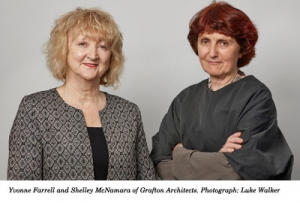Network rail looks to engage commuters in it’s design plans with the help of an app
Use of AR – a first for Network Rail – puts architects’ designs into passengers’ smartphones. |
| Network Rail has contributed its design data to an app that enables passengers to use augmented reality (AR) to see replacement footbridges at stations. The app will support Network Rail’s engagement with passengers while delivering footbridges across the network throughout Control Period 6 (1 April 2019 – 31 March 2024) and beyond. The app, called ARki and developed by Darf Design, provides 3D visualisations of planned buildings in situ. Thanks to the collaboration with Network Rail and Wood, ARki now incorporates the footbridges, helping passengers and local communities see their future as Network Rail rolls out its new generation of signature footbridges. Available in the Apple app store from 16 October, the app’s cutting edge AR technology gives Network Rail a new level of engagement with rail users. Network Rail has developed three footbridge designs that blend forward-thinking architecture with creative engineering, bringing a new level of quality and a distinctive identity as the current, standard model is replaced in the years ahead. The three designs are: The Beacon – a fully glazed bridge featuring lantern-topped lift towers and a dynamic articulated engineered structure The Ribbon – an update of the classic arched footbridge with an elegant floating canopy spanning the track, featuring 30-degree lift and stair rotations The Frame – a radical expression of minimalism that offers a range of flexible, functional configurations. Winner of the Network Rail and Royal Institute of British Architects (Riba) footbridge design competition of 2018, this design by Gottlieb Paludan Architects of Denmark was judged best among 120 entries from 19 countries. “The app will give our customers a glimpse of their future station, using new technology to give a level of detail we’ve never provided before,” said Anthony Dewar, professional head, buildings and architecture at Network Rail. “As well as keeping local people informed of changes to their station, it provides a fitting, high-tech showcase for our exciting new footbridge designs. We’re very proud of the three new designs and want as many people as possible to be aware of and appreciate them – the app is the perfect way to showcase the footbridges to as large an audience as possible.” The app integrates the architects’ design files into a smartphone’s video footage through ARKi. “Our vision is to allow designers to share their 3D models in the real world,” says Sahar Fikouhi, founder of interactive design studio Darf Design and developer of ARki – recently shortlisted as one of the 10 companies to join Digital Catapult’s Augmentor programme, which is helping to accelerate UK investment in immersive technologies such as AR. “It’s very rare for the public to have this access to genuine architects’ drawings and this is one of the first examples of one-to-one scale visualisations of future projects. The app is helping to democratise the way structures are designed and built by giving the public this access at early stages of design selection,” added Fikouhi. Wood has taken on the role of technology integrator, building on their work with Network Rail and in stakeholder engagement. “Wood is proud to assist Network Rail in its mission of engaging the public during introduction of high quality design and engineering into its estate through this transparent process. The integration of such technologies for our clients helps keep all interested parties engaged,” says Charles Humphries, Director – Built Environment at Wood. “Having managed stakeholder engagement on a number of major infrastructure projects, we are fully aware of the importance of community involvement. Showing passengers what their bridge will look like is a great way of winning over the hearts and minds of rail users,” says Humphries.
|
Modular construction, home-sharing platforms and rental tools could be the answer to housing challenges in the US, believes Nate Loewentheil of venture capital firm Camber Creek.
At a time when macroeconomic and political forces are aggravating the challenges of affordable housing in the US, a new set of technologies, including modular construction, digitally enabled home-sharing and new financial tools for renters, are helping reduce housing costs and expand housing access.
There are a number of reasons why city policy-makers should encourage these new companies by inviting them to pilot new technologies, using city contracting power and reducing regulatory burdens.
Worsening problem
According to Harvard’s Joint Centre for Housing Studies, approximately one-third of US households are cost-burdened by housing, and more than a quarter of US renters spend more than half their income on housing. Current trend lines suggest the problem is getting worse.
According to an analysis of home prices by the National Association of Realtors, every single major metropolitan area grew less affordable between 2017 and 2018 (the latest year for which the housing affordability index is available).
Depending on your perspective, you can ascribe the challenges in the housing market to general economic conditions, to local regulations, or to federal policy. The market for new housing is shaped in large part by the costs of construction, especially wages. During a booming economy, construction wages increase sharply.
According to the Federal Reserve of St Louis, hourly construction wages have risen more than 20 per cent since 2012, from $25.50 to $30.75. At a broader level, wages for millions of working Americans are simply too low to meet the prevailing costs of safe, adequate housing.
Starting during the New Deal, the Federal government stepped in to fill this gap and subsidise housing for lower-income Americans. For the past few decades, however, federal policies have generally shifted against low-income renters, aggravating the affordability crisis.
Just in the past few years, according to the Urban Institute, the share of low-income renters with housing needs receiving federal assistance dropped from 24 per cent in 2005 to 21 per cent in 2015.
Local regulations can severely aggravate (or ameliorate) the challenge. For example, San Francisco has some of the most restrictive zoning policies in the country, which has led to a crisis of affordability. To afford to buy the median home in San Francisco, a family has to be making $198,000 per year.
Error, group does not exist! Check your syntax! (ID: 2)
Lessons from history
Across time and geographies, technology has served as a counter-weight, consistently driving down housing costs, improving quality and expanding access.
As historian Kenneth Jackson explains in the book Crabgrass Frontier, balloon framing, a new construction method developed in the 1830s, allowed amateur carpenters to use standard schematic models, standard wood products and mass-manufactured nails to quickly build long-lasting, stable homes, dramatically reducing housing construction costs during the middle decades of the 19th century.
After World War Two, builders like Levitt & Sons applied new industrial techniques of mass manufacturing to home production, with each worker taking responsibility for a single task and working across multiple building sites, like an assembly line in reverse, again driving down costs.
Other technological innovations – like steel and reinforced concrete – made it possible to build larger and taller apartment buildings, bringing down per-unit costs.
Today, new technologies promise similar benefits for homeowners and renters, especially modular construction and home-sharing platforms. New financial tools are also helping more individuals access quality rental homes and build financial stability.
As the New York Times recently reported, in high-end markets, building a unit of low-income housing can cost as much $500,000. One alternative is modular housing, where standardised panels, rooms or apartments are built offsite. Modular housing can reduce the costs of quality control and inspection, avoid weather-related slowdowns and provide certainty for developers concerned about the timing of project completion.

Chicago-based construction company Skender, for example, is deploying modular homes for developers around the Windy City. They are one example among literally dozens, including Blokable, Factory OS, Boxabl and Indwelligent.
City and county governments can encourage modular construction by ensuring that building codes allow for modular buildings and by providing expedited permitting.
Relevance of the sharing economy
New construction is one part of the puzzle but there is a vast untapped resource: spare rooms in existing homes. Homeowners have been letting rooms for rent since there were homes but historically the transaction costs to rent out a room were high: advertising, screening and collecting rent.
The rise of the sharing economy has reduced those costs. Companies like PadSplit and Nesterly are helping homeowners split up their homes into multiple units or rent out spare bedrooms – of which there are at least 50 million in the US. In the process, they are creating new low-cost rental inventory, often of higher quality and in better locations than the alternatives. Cities can encourage room and home-sharing by updating regulations around rental properties and through tax policies.
For low-income renters, the biggest challenge may be accessing housing in the first place – and keeping a home once it is rented. A new set of companies are helping low-income families navigate the rental landscape at every step of the journey. OneApp provides renters with a list of apartments that will accept their credit and criminal background status, helping avoid costly application fees.
RentLogic gives renters new tools to evaluate buildings before they rent, avoiding absentee or derelict landlords. Jetty offers landlords a surety bond that allows potential renters to pay a one-time fee instead of a security deposit, helping lower-income families access a broader range of apartments.
The fee is usually around 20 per cent of the security deposit. Till, a company founded in 2018, provides short-term loans to renters to meet rent and avoid eviction on terms far cheaper than traditional payday loans.
Together these companies and others are offering a new rental roadmap that can meaningfully improve the lives of low-income Americans.
Modular construction, home-sharing platforms and rental tools are only three examples of the technologies that are helping to lower costs, improve quality and expand access to housing in the US.
Even as labour markets continue to tighten and federal support for low-income housing grows scarcer, cities and towns around the US can encourage these new companies and others like them to start making housing more affordable today.
Source: Smart Cities World
Construction on a low-cost vertical spaceport in the north of Scotland may commence within a year, pending the approval of a planning application by a local authority.
The spaceport, to be called the Space Hub Sutherland, would be built at A’Mhoine on the Moine Peninsula in the county of Sutherland, a few miles from Scotland’s Atlantic coast. This facility would enable vertical rockets to launch small satellites into low Earth polar and sun-synchronous orbits.
In early August, the Highlands and Islands Enterprise (HIE), a local Scottish government economic and community development agency, signed a 75-year option to lease the land where the spaceport would be built.
Error, group does not exist! Check your syntax! (ID: 2)
The development, which would cost $20.7 million, received $3 million of funding from the U.K. Space Agency in July of 2018.
“We hope to get planning consent in early 2020 and start construction soon after that,” Roy Kirk, Space Hub Sutherland project director at HIE, told Space.com. “If all goes well, we will see launches from Sutherland by the early 2020s.”
Earlier this year, HIE awarded a contract to architecture firm NORR Consultants to design facilities at the spaceport, including a launch-control center and the assembly and integration building.
“We believe that the vertical launch opportunity that we are developing will deliver a really cost-effective and low-cost access to space,” said Kirk. “Each launch will have a very tight price point, and we hope to achieve very short lead times for these launches.”
Orbex
Lockheed Martin and the British aerospace company Orbex previously committed to launching from the Sutherland spaceport, hoping to carry out up to 10 launches per year.
Earlier this year, Orbex unveiled the second stage of the company’s innovative Prime rocket, which uses a biopropane fuel and emits 90% less carbon dioxide than conventional, hydrocarbon-fueled rockets. Biopropane is an alternative to natural gas that’s produced from waste or sustainably sourced materials like algae.
The company’s CEO, Chris Larmour, welcomed the recent lease option as an important step toward taking Britain “back to space,” he said in a press statement in an email.
Orbex aims to operate the A’Mhoine site in a “‘green’ manner and will be using a site-compatible small launch vehicle with an ultra-low-carbon biopropane fuel,” Larmour added. The environmental impact of the operations is currently being scrutinized, as the proposed site lies inside a recognized area of natural and scientific interest.
UK rockets
Previously, the United Kingdom developed a functioning rocket, the Black Arrow, which launched from Australia and flew only four times before being abandoned in 1971 due to the high cost of the program.
It is not clear yet what vehicle Lockheed Martin is looking to launch from the Scottish spaceport, but the company received $31 million from the U.K. Space Agency last year to develop and operate a vertical launch system from the Sutherland Space Hub. Orbex received $7 million toward its efforts.
Orbex announced a series of launch contracts for the company’s Prime rocket, including recent agreements with the Netherlands-based cubesat launch broker Innovative Space Logistics and the U.K.-based company In-Space Missions, which plans to launch its Faraday-2b demonstration satellite from Scotland in 2022.
The Space Hub Sutherland, however, is not the only anticipated spaceport in the U.K. In May, the U.K. Space Agency announced 2 million pounds sterling ($2.44 million) of funding for the development of horizontal spaceports, from which aircraft carrying small rockets, such as the Virgin Galactic LauncherOne, could take off like regular aircraft.
There are currently four sites in the U.K. — including Newquay in Cornwall, Campbeltown and Glasgow Prestwick in Scotland, and Snowdonia in Wales — looking to develop horizontal spaceports. The U.K. government hopes that these sites will not only enable small satellite launches, but also allow space tourists to take off from British soil in the future.
RELATED
Cick the image to view the video of the Virgin Galatic Space Launch centre in New Mexico, designed by the UK Architects Foster and Partners
Solstice Arts Centre, Navan, Ireland by Grafton Architects, winners of the 2020 RIBA gold medal. Photograph: ©Ros Kavanagh
The Dublin cooperative, known for brutalist buildings that create generous open spaces, is only the second women-led practice to win the prize.
Grafton Architects, the Dublin practice led by Yvonne Farrell and Shelley McNamara, has been named as the recipient of the 2020 RIBA gold medal, the UK’s highest honour for architecture. It marks just the second time in the award’s 172-year history that the prize has been given to a women-led firm, following Zaha Hadid’s win in 2016.
It says a lot about the duo that their practice is named not after themselves, but the street in which they set up their office. For Grafton, place is more important than personality, and making good buildings a higher priority than theory, rhetoric or appearing in magazines.
Architecture biennale 2018: all hail the new queens of Venice
 If Farrell and McNamara don’t fit the usual celebrity architect mould, their buildings also feel of another era. They are interested in weight, mass, and the play of light on hefty volumes of concrete and stone. They sculpt spaces from great mineral slabs and soaring buttresses, carving out volumes in a manner reminiscent of heroic brutalist buildings of the postwar era. Their structures sometimes have an archaic, primitive quality, providing robust armatures for any number of different uses that might occur within their walls over the coming centuries that they look designed to endure. In a world of lightweight frames and clip-on cladding systems, this is solid architecture that is built to last.
If Farrell and McNamara don’t fit the usual celebrity architect mould, their buildings also feel of another era. They are interested in weight, mass, and the play of light on hefty volumes of concrete and stone. They sculpt spaces from great mineral slabs and soaring buttresses, carving out volumes in a manner reminiscent of heroic brutalist buildings of the postwar era. Their structures sometimes have an archaic, primitive quality, providing robust armatures for any number of different uses that might occur within their walls over the coming centuries that they look designed to endure. In a world of lightweight frames and clip-on cladding systems, this is solid architecture that is built to last.
Grafton’s medal win follows the award of the inaugural RIBA international prize in 2016 for the “best new building in the world”, which went to their jaw-dropping building for the Universidad de Ingeniería y Tecnología (UTEC) in Lima, Peru. Standing above a motorway like a chunk of a stadium, the muscular concrete structure provides laboratories and classrooms in a vertiginous stack of terraces, connected by open walkways and meandering social spaces, feeling like a true extension of the city, cleft from the hillside.
“We like to create spaces you couldn’t design consciously, things that just happen somehow,” McNamara told me at the time. “Rather than thinking of a space and then finding a structure for it, we make a structure and that, in turn, makes a space.” They say they are interested in “the spaces in between, which haven’t been asked for in the brief” and describe their architecture as a kind of “scaffolding”, a non-prescriptive framework on which lives and events can be played out.
Error, group does not exist! Check your syntax! (ID: 2)
Selected to curate the Venice Biennale in 2018, they set the theme as “Freespace”, which they described as “a generosity of spirit and a sense of humanity at the core of architecture’s agenda”. They spoke of the “free and additional spatial gifts” that architecture can offer – a core idea of their own buildings, which often feature generous, open, free-form spaces to be occupied as people see fit. Steps, benches, terraces and broad landings loom large. Current projects in the works for universities, including the London School of Economics, Kingston University and Toulouse, are all conceived as open, inviting forums.
Source: The Guardian
Digital twins and AI help to bridge the construction productivity gap
Bam Nuttall, Cranfield University and Iotic create The Learning Camera
In a drive to increase on-site productivity and operational performance in the construction industry, BAM Nuttall has teamed up with tech-firm Iotic and researchers at Cranfield University to develop an AI-based, computer-vision system using new digital twin technology.
The Learning Camera project employs a standard webcam, integrated with an IoT framework of smart sensors to collect real-time environmental data such as wind speed and weather conditions, combined with contextual information including location, date and time. All this data is fed into a cloud-based system to create digital twins, which bridge the physical and virtual world.
An Iotic digital twin is an autonomous and interoperable version of a ‘thing’ or an asset with all its data and controls that can interact, interrelate and behave in a digital environment as its twinned counterpart in the real world. Pairing these two worlds with the Learning Camera enables the monitoring and analysis of on-site data to identify and head off problems before they cause potential delays, accidents and increased costs, while also helping with future planning by being able to run accurate simulations with real data.
In particular, cameras can be programmed to recognise abnormal activity on a construction site 24 hours a day and generate alerts so that someone can attend to rectify any problems. This reduces the need for repetitive on-site checks and security monitoring in hazardous areas and all-weather conditions.
Sophie Peachey, Head of Customer Success at Iotic, said: “The application of Digital Twin technology within the Learning Camera allows us to broker access to a potentially increasing number of data sources and controls to perfect the accuracy of the algorithms used in the solution. These algorithms must be able to interpret differences correctly and instigate appropriate actions to make the Learning Camera a solution that people trust. You can see how this could apply to different situations in which people have to balance the importance of knowing that something is there, has changed, or is working, against the cost of their time in checking. While this is not restricted to construction, we are very excited by the impact this could have on productivity and in providing construction staff with a safe working environment.”
Dr Yifan Zhao, lecturer in Image and Signal Processing and Degradation Assessment at the Through Life Engineering Service Institute at Cranfield University, said he believed the innovation was a great opportunity for AI to be applied to a traditional industry. “By using The Learning Camera, construction sites will be better equipped to manage and deliver projects. Its use will also promote the need for the industry to attract talent with skills in software and hardware development in order to tackle the much-publicised poor productivity levels.”
And Colin Evison, head of innovation at BAM Nuttall, concluded: “Overall, lessons are learned and opportunities are uncovered within the virtual environment that can be applied to the physical world and used to transform a business. This is a real opportunity to explore how we can make construction projects smarter by the adoption and development of technology solutions which have not been traditionally available before.”
GREEN energy has come a long way since John Blyth installed the world’s first electricity-generating wind turbine to charge a battery at his holiday home in Scotland.
That was July 1887, and it was not until 1951 that the first utility grid-connected wind turbine to operate in the UK would be built in the Orkney Islands.
Two decades later and industrial scale wind generation was proposed, but progress has not been fast.
It was another 20 years before the first commercial windfarm opened in Cornwall.
Over the last 25 years public opinion has been mixed, especially for onshore wind farms, where residents at planning committees for contentious developments have claimed they will be a “blot on the landscape”, as well as citing concerns over efficiency, the effect they have on animals, the noise they emit and potential health risks.
Most fears appear to have been quelled, but to avoid “nimbyism”, they now tend to be built out at sea, and last year, wind power contributed to 18 per cent of the UK’s electricity generation.
Russell Edmonson, managing director of Tekmar Energy, which is based in Newton Aycliffe, says: “A lot of people don’t realise just how much electricity is produced.
“It is quite staggering how many wind farms there are, even in the UK, and the UK is the market leader for it.
“People do not realise it because they are over 20 miles away offshore.”
Tekmar Energy recently signed a contract with the world’s largest offshore wind developer Ørsted, to provide its patented cable protection systems for the Hornsea Two offshore wind farm.
The 30 metre-long systems, made from polyurethane and cast iron, connect to the seabed, and the cable to land, and the bottom of the wind turbine base, to prevent the thick wiring being damaged by the saltwater of the sea, tidal movement and storms.
The new wind farm will be made up of 165 turbines with a combined total capacity of 1.4 GW, providing clean electricity to well more than 1.3 million homes.
The sister project to Hornsea One, which has 170 smaller turbines, is set for completion in 2022 and Tekmar, which employs 115 people, will be providing 346 cable protection systems.
Error, group does not exist! Check your syntax! (ID: 2)
Russell says: “Around 60 per cent of our revenue is in offshore renewables or wind farms.
“It is the only way to mass produce renewable technology. As an industry, it is growing at around 20 per cent per annum.
“What is very interesting is a lot of big developers are now competing at a zero subsidy level.
“They are undertaking projects with no subsidy from the Government and that means, as an industry, it is slowly transitioning from a Government decision to a commercial decision.
“It is opening up the rest of the world. Europe has led the way in offshore wind power and the technology has been developed and proven. Now the Americans are slowly starting to get on board and we are doing lot more work in Asia. It is very much a growing industry and there is huge potential.”
Tekmar was started by two Norwegian oil and gas industry divers in 1985 as an engineering and projects business, but over the last three decades has transitioned into making products on site and moved into renewables in 2008.
Wind turbines are made in mainland Europe by suppliers such as Siemens before blades are shipped and completed in Hull, but Russell says several companies in the North-East make up the rest of the supply chain.
He says the growing awareness of the need for green energy production means there is now plenty of scope for further opportunities for employment in the sector.
“The North-East is a hub for offshore companies,” he says. “You ultimately have pretty much everything you need, except the turbines, in the North-East to build a wind farm, which is pretty unheard of.
“You have everything from companies who are product suppliers to cable manufacturers to installers.
“There is an entire supply chain in the North-East. It is an industry that is growing so there is huge scope for job creation.
“It is very much a projects industry. We are very much driven by when these projects are green-lighted and how quickly they can go into production.
“The good thing about the renewables market is there is a lot of foresight in the pipeline so you can see what is coming from 12 to 24 months out.”
Source: The Northern Echo
With flood risk being the primary danger to waterfront homes across the UK, Baca Architects has won the go-ahead for two new houses on Christchurch waterfront in a decision that not only reflects the firm’s exemplary approach to flood resilient design but also overcomes an inherent flaw in national planning policy on building within floodplains.
The houses feature the latest in sustainable architecture. Designed to be manufactured off-site, these highly insulated homes will have low carbon footprints and can be assembled quickly. The interiors will be bathed in sunlight and generous balconies will provide shade to full-height glazed windows that afford panoramic views out over the estuary. Importantly, all bedrooms are located above ground level while the living room, kitchen and dining room are approximately 2.5 feet above the external ground level and outside the flood plain. All electrical services will be brought in from the first floor and all electrical sockets will be raised. Windows and doors will allow water control and safe egress at multiple locations around the building. In the event of a flood, and should water enter the ground floor, the internal construction is designed to be resilient to water and to enable effective cleaning and fast recovery.

The successful scheme – the first of its kind under the recent changes to National Planning Policy Framework (NPPF) – challenged the effective prohibition on homeowners, developers and local authorities to re-build innovatively and safely on sites where pre-existing housing stock had already suffered, or was likely to suffer, flooding. The site in Christchurch is currently designated an area of low flooding risk but is calculated to progress to one of high risk over the next 100 years and the client wished to replace two dilapidated bungalows with two flood resilient homes. Whilst the proposal offered significant betterment in terms of safety on-site, improved on-site drainage and no net increase of development in the flood plain, the project ran into a major obstacle due to changes to the NPPF in 2018. These aimed to put an end to new waterfront housing developments but in so doing also posed a direct problem for owners of existing waterfront or flood plain homes seeking to protect their properties.
Error, group does not exist! Check your syntax! (ID: 2)Richard Coutts, Principal of Baca Architects, explains:
“This is a huge issue for waterfront and floodplain homeowners. If they wish to upgrade pre-emptively or rebuild in the wake of a destructive flood event, they may well be stalled by the policy phrasing and ultimately rendered homeless. In the context of increasing flood plains and worsening flood events, building innovatively and safely needs to be embraced, marrying the best in architectural design with a focus on flood resilience and the protection of the environment. Flood resilience does not have to compromise design aesthetic or budget so long as it’s designed in from conception. The planning success of the Christchurch application sets the precedent of safeguarding such schemes where they are on sites of flood risk and where development already exists”.
Baca’s scheme was granted planning consent earlier this month and is expected to be on-site in summer 2020.
PAGE DOWN FOR THE VIDEO’s
Imagine a road with no asphalt, no concrete, just post-consumer plastic waste. This is possible in the Netherlands!
Smart City developments are rapidly advancing the way we live, work, and commute in our daily life. Smart City infrastructure is currently seeing a high-level of innovation toward a more sustainable future in the Netherlands. Using post-consumer plastic waste PlasticRoad builds sustainable roads of plastic reducing plastic pollution along the way.
From plastic pollution to recycled plastic smart roads
Consumer plastic waste represents a serious problem that is damaging the environment and many species on the planet. Globally, more than 40 species of fish are known to consume plastic. Eventually, that plastic reaches human plates.
Packaging alone generates 141 million tonnes annually of single-use plastic waste, being responsible for almost half of global plastic waste. This is the sector which also uses the most plastic: 146 million tonnes per year, representing 42 percent of the global total.
The innovative and unique concept of building roads made of plastic contributes to solving the overwhelming problem of plastic pollution. The idea of plastic roads was conceived by looking at the problems that municipalities, provinces, regional water authorities and contractors deal with on a daily basis including societal problems such as plastic waste, extreme precipitation, consolidation of the subsoil, an increasing need for mobility, and a crowded subsurface as well as the increasingly stringent requirements for future roads.
The increasing demand for more functionality from roads began to raise the question of whether the traditional asphalt is still the answer to these increasingly stringent requirements.
If roads in smart cities should have an increasingly longer lifespan, shorter construction and maintenance time, be more sustainable, achieve ever-higher noise reductions, and also be financially competitive then roads made of plastic is what ticks all the boxes and what inspired the idea of the PlasticRoad initiative.
Zwolle: Historical, trendy, and home of the world’s first plastic road
Zwolle is a city west from Amsterdam, reachable by train in just one hour. Zwolle is both historical and trendy. The city hosts one of the biggest markets in The Netherlands with 450 stalls. Art works from Dutch painters Vincent van Gogh and Piet Mondriaan delight art lovers who visit the Museum of Fundatie.
It is here, in Zwolle, where the world’s first plastic road prototype was built using recycled single-use plastic.
The first internal trial was ready in 2016. For over a year, cars and small trucks drove over the small plastic road every day without presenting any difficulties. Finally, in 2018, Zwolle became the first official city in the world to have a truly plastic road.
The Netherlands is well known for its heavy use of bicycles that populate the Dutch cities contributing to the promotion of clean and fresh air, daily exercise, and less general pollution.
On September 11, 2018, a 30-meter bike path opened to the public in Zwolle. The road includes sensors which collect data proving information for further development, space for services to run underneath, and its own stormwater management system.
Building the plastic road presented many advantages including cheaper materials than traditional road-building materials and less time required for complexion before the road was fully installed.
The video below shows how the plastic road was installed:
After the success of the first plastic road, a second one was installed in late 2018 in the city of Giethoorn, also in The Netherlands. In this occasion, the goal was to test how the plastic road responded in weak soil conditions.
PlasticRoads plans on building more bike paths, pedestrian areas, and car parks around other cities in The Netherlands. Looking into the future, the three PlasticRoad partners are planning on building urban highways made of plastic.
In the future, single-use plastic might become a thing of the past. Presently, consumers use 500 billion single-use plastic bags per year with 75 percent of post consumer plastic waste being sent to a landfill.
It takes 10 years to 1,000 years for a single-use plastic bag to decompose. Plastic bottles take 450 years, in many cases it could take even more than that. Think all the plastic bottles you have discarded in your whole life will still be around polluting the planet centuries after you die.
Building plastic roads the LEGO way: Advantages
- It is a lightweight prefabricated construction that can be built pretty much the LEGO way. It is four times lighter than a traditional road structure
- Faster construction (months shorter) and less maintenance time
- Higher quality and a longer lifespan. It is homogeneous and prefabricated. The lifespan is two to three times longer than a traditional road paving
- Little to no maintenance required. The material is virtually impervious to conditions such as the weather and weeds
- The innovation is considerably more sustainable. The goal is to make the PlasticRoad out of 100 percent recycled plastic and to make it fully reusable. It is perfectly in line with the Cradle to Cradle philosophy and the principles of the circular economy
- Double use of space. The hollow space in the design can be used to store water or as space for cables and pipes
- The possibility of constant traffic safety and water drainage
- Everything on and around the road can be prefabricated including road markings and guardrails
- It is scalable. The concept offers opportunities for further innovation. Examples include solar heated roads, light poles, and traffic loop sensors
- A great added advantage is the contribution to the global social problem of plastic waste in an innovative and sustainable way
PlasticRoad is an innovative concept initiative of KWS, a Royal VolkerWessels company and market leader in road construction and the production of asphalt in The Netherlands. KWS partnered with Wavin, a company which operates within Orbia, and is a market leader in the recycling of plastics as well as specialist in making recycled plastic products for drain water drainage, and also with Total, to improve the properties of plastic, the recycling of plastic, and the available production techniques.
It all started when leading road builder KWS’ engineers came up with a smart solution to build more sustainable roads: Using plastic. Since then, the group has grown with partnerships that join forces to make cities smarter and sustainable.
Orbia is a purpose-driven company that aims to advance life around the world by focusing its business solutions on addressing six of the world’s biggest challenges aligned with the UN Sustainable Development Goals. One of them is to make cities more livable, lovable, resilient, and regenerative.
By Susan Fourtané
Source: Interesting Engineering
Modular homes manufacturer ilke Homes has launched the UK’s first onsite academy to train house builders and engineers to make homes in factories, to help ease the construction skills and housing crisis.
The ilke Academy will hire people from all walks of life, including school-leavers, military veterans and ex-offenders. These groups are under-represented in traditional construction and manufacturing.
The ilke Academy will be based next to the ilke Homes factory in Knaresborough, North Yorkshire, which currently has capacity to produce 2,000 homes a year. This will enable new recruits and existing staff to learn a range of vital skills including engineering, plumbing, manufacturing, carpentry and design.
The academy will also support trainees’ professional growth, with a leadership development course in place offering recruits internal progression opportunities and a clear career path in the emerging modular housing industry. The academy will welcome 162 recruits and further the training of current ilke Homes employees, with applications open to 17-year olds through to those extending their career beyond retirement.
The launch of the ilke Academy – the first ever on site academy focusing on homes built in a factory – follows similar measures undertaken by the Mayor of London Sadiq Khan, who announced the Mayor’s Construction Academy, focusing on traditional construction, in 2018.
Through its academy, ilke Homes says it wants to train people typically viewed as unskilled or unemployable while also supporting the local economy.
Its management team hopes that by setting up networks with a local men’s and a local women’s prison, they can prevent re-offending and promote house building to a new generation of people, while providing stable employment opportunities in an emerging industry.
ilke Homes want to work with careers advisors to help change perceptions and address the considerable lack of young people entering construction.
In June, the business agreed the UK’s largest ever modular housing deal with Places for People for 750 homes. The company is currently working with private housebuilders, housing associations, councils and retirement community developers to supply high quality homes accredited by BOPAS and backed by the NHBC warranty.
Dave Sheridan, Executive Chairman of ilke Homes, said: “We have a responsibility to help people from all backgrounds find employment and for too long, the construction sector has sat on its hands while the skills shortage has hit crisis point.
“Creating local jobs and helping get more women and young people into the sector have to be priorities. The Government has ambitious targets to build new homes and only through investment in factories will this realistically happen. Investment will only flow if the right skills exist – and that’s why we are keen to collaborate with everyone in the industry.
“Offsite manufacturing gives people a genuine, clear career path together with the opportunity to play a part in disrupting UK house building.
“Anyone, be they a school-leaver seeking their first full-time job or a reformed offender, should have the chance to be trained – not least when they can help end the housing crisis by building beautiful, high-quality homes.”
Duncan O’Leary, Chief Executive of the New Futures Network, a specialist part of Her Majesty’s Prison Service, said: “This is a fantastic initiative that will benefit ilke Homes, the individuals involved and the families and communities they are part of.
“Training and work placements in prisons equip offenders with skills they can use to find employment upon release. Having a job helps them get their lives back on track and ultimately keeps the public safe. By offering ex-offenders training relevant to their business, ilke Homes are joining over 300 employers that already benefit from hiring skilled people from prisons.”
Nigel Adams MP, Member of Parliament for Selby and Ainsty, said:”It’s no secret that the construction industry has struggled to cope with the ongoing skills shortage. The launch of the ilke Academy represents a huge step in the right direction in teaching new skills for local people from all walks of life, creating new and exciting jobs, whilst boosting our local economy.
“I am delighted to see that Yorkshire has established itself as a hotbed of housing innovation. This will be vital as we continue to reverse the brain drain that the capital has swallowed up and ensure that we can attract top talent to the region.”
Gill Cronin, Director of Operations at The 5% Club, said: “The ilke Academy is a very welcome step to establishing a factory-focused workforce to build homes of the future.
“Ensuring that people are engaged, trained and educated in modern methods of construction is crucial if this nascent industry is to grow quickly. It’s vital that the private sector takes greater responsibility for equipping future employees with the skills and knowledge needed to create the homes of tomorrow.”
Source: The Business Desk
With the opening of its City Intelligence Lab (CIL), the Center for Energy, the Austrian Institute of Technology (AIT) is setting a new milestone in its research infrastructure.
“The City Intelligence Lab at the Center for Energy is bringing about a paradigm shift by using digital technologies to include user perspectives, making the lab an international model when it comes to urban planning processes of the future,” says Wolfgang Hribernik, Head of the Center for Energy, at the opening. Functioning as an interactive platform, the City Intelligence Lab combines innovative processes with the latest digital planning tools using big data and artificial intelligence (AI). It is therefore able to realistically simulate and run through scenarios such as the climate situation in different parts of the city.
City Intelligence Lab – an international model laboratory
The laboratory is an interactive platform designed to allow tomorrow’s urban planning professionals to investigate new methodologies and technologies and takes a co-creative development approach, enabling the joint creation of new knowledge. “In establishing this laboratory we have produced a platform and a space for experimentation, what you could call a sort of medical laboratory for digital technologies,” says Nikolas Neubert, Head of the Competence Unit for Digital Resilient Cities at the Center for Energy.
The laboratory applies key technologies such as augmented reality (AR) and artificial intelligence in order to develop complex simulations and parametric designs. “The innovative achievement of tomorrow’s urban planning will be to apply digital technologies in order to create diverse planning scenarios which offer a broad portfolio of solutions for cities and their inhabitants. We have created the infrastructure necessary to do this,” Nikolas Neubert goes on to explain. The laboratory is equipped with interactive projection screens and models which together provide an improved collaborative planning environment, as well as an AI-based urban planning model which combines real-time simulation prediction and generative design, enabling the experts to explore unprecedented situations.
By working closely with other research institutions such as the Future Cities Lab at the ETH Zurich, and through close links with the private sector, the CIL is designed to become an international hub which facilitates the development of new research approaches.
Climate change and digitalisation in cities demand new ideas for planning and implementation
Urbanisation is a modern phenomenon. It requires cities to intelligently manage their growth and find answers to the challenges of climate change.
“Again, this year, we experienced an extreme heatwave. The growth and increased densification of cities only enhances the problem of overheating during the summer months,” explains Nikolas Neubert. Overheating is understood as the growing number of very hot days which reach a maximum temperature of over 30°C, and tropical nights in which the nighttime temperature never falls below 20°C. This development poses a health burden for the population.
“In order to make cities more resilient to this situation, we can use machine learning in the City Intelligence Lab to simulate microclimates for summer days and heatwaves, both with and without adaptation measures, to run through different climate models, and to present the results in visual form. This allows us to immediately identify the measures which would be effective in helping to cool particular areas of the city,” Nikolas Neubert says.
Digital technologies shift the focus of urban planning to the needs of residents
The innovative achievement of urban planning will be to use digital technologies in order to create diverse planning scenarios which offer a broad spectrum of solutions for cities and their inhabitants. In the LiLa4Green project, for example, a research team led by the AIT Austrian Institute of Technology is working together with city residents in two districts of Vienna to develop ideas and solutions to counteract urban overheating in parts of the city. The Living Lab approach combines innovative social science methodology with cutting-edge digital technologies in order to involve citizens in Wien Favoriten and Matznerviertel (Wien Hietzing) as early on in the planning process as possible. The aim is to ensure that the measures have a significant social impact and are widely accepted. In September 2019 LiLa4Green was selected as a candidate for IBA_Vienna 2022. LiLa4Green is being funded by the Climate and Energy Fund – Smart Cities Demo.
Innovations for cities and the built environment
In its Digital Resilient Cities research field, the Center for Energy at the AIT Austrian Institute of Technology blends urban planning expertise with state-of-the-art city management and planning solutions. The researchers combine innovative processes with cutting-edge digital planning tools using big data and artificial intelligence (AI). Although the research projects are based in Austria, a large proportion (60%) of them are international. Know-how “Made in Austria” is in demand everywhere, whether in Germany, Argentina or Uzbekistan.
AIT Center for Energy
At the AIT Center for Energy over 200 experts are developing sustainable solutions for our future energy system under the leadership of Wolfgang Hribernik. The Center combines longstanding experience and scientific excellence with high quality laboratory infrastructure and a global network to offer companies innovative applied research services, providing them with a competitive edge in this promising market. A total of 370 research projects were carried out in 2018, with European projects accounting for 41 percent. The thematic portfolio of the Center for Energy focuses on three key systems: sustainable energy infrastructure, decarbonisation of industrial processes and facilities, and innovative technologies and solutions for cities and the built environment. More information about the Center can be founc on this link
MMC is published by Waverley Publications Limited
Registered office Sibrwd Y Dwr, Station Road, Llwyngwril, Gwynedd, LL37 2JS
Reg. No. 13018966
Pages
Categories
Archive
- November 2025
- September 2025
- July 2025
- May 2025
- April 2025
- March 2025
- January 2025
- December 2024
- November 2024
- October 2024
- September 2024
- August 2024
- July 2024
- June 2024
- May 2024
- April 2024
- March 2024
- February 2024
- January 2024
- December 2023
- November 2023
- October 2023
- September 2023
- August 2023
- July 2023
- June 2023
- May 2023
- April 2023
- March 2023
- February 2023
- January 2023
- December 2022
- November 2022
- October 2022
- September 2022
- August 2022
- July 2022
- June 2022
- May 2022
- April 2022
- March 2022
- February 2022
- January 2022
- December 2021
- November 2021
- October 2021
- September 2021
- August 2021
- July 2021
- June 2021
- May 2021
- April 2021
- March 2021
- February 2021
- January 2021
- December 2020
- November 2020
- October 2020
- September 2020
- August 2020
- July 2020
- June 2020
- March 2020
- February 2020
- January 2020
- December 2019
- November 2019
- October 2019
- September 2019
- August 2019
- July 2019
- June 2019
- May 2019












